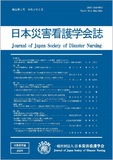Japanese
English
- 有料閲覧
- Abstract 文献概要
- 参考文献 Reference
- サイト内被引用 Cited by
要約
目的:2005年3月に発生した福岡県西方沖地震で甚大な被害を出した玄界島の復興過程を分析し、災害以前、発災時、避難から帰島、帰島後のコミュニティ・レジリエンスを抽出する。
方法:事例研究。
結果:災害以前は、様々な災害や危機へのコミュニティとしての対処によってコミュニティ・レジリエンスの潜在能力を高めていた。発災時は日常の防災訓練が生かされ、全員が発災までに形成されていた災害に対処する能力を発揮し避難できた。全戸避難から住宅再建・帰島までは、漁協組合長の強力なリーダーシップや「八軒竃」、もやいで培われた共同性が発揮された。住宅再建・全戸帰島後は、住宅再建・帰島によって「ひと段落」「一休み」という気分があり、「(災害体験)の風化」が生じ、コミュニティレジリエンスは低下している。
結論:災害サイクルのすべての時期においてコミュニティ・レジリエンスの基盤となるのは、コミュニティ成員の共同性と共通の関心−コミュニティ・アイデンティティである。
This study aims to explore the community resilience in Genkaijima Island examining the four phases such as before the Fukuoka Seiho-oki Earthquake occurred in March 2005, at the time of disaster, during the evacuation and returning, and after returning to the island.
It is analyzed multidirectionally the recovery process of the earthquake by the literature on Genkaijima Island, interviews and district surveys.
Before the earthquake, community resilience was developed by coping with various disasters and crises.
When the earthquake hit the island, people could escape to some safety places and then they were evacuated to Fukuoka city, which was the result of the regular disaster drills.
The leadership of the president of the fishermen's cooperative association and the one of both “Hachikenkamado” and “Moyai” cultivated by the community cooperation were shown from the time of all houses refuge to the time of returning to the island.
Community resilience in Genkaijima Island has been declining in recent years, because people were relieved from difficulties in shelters, and then they gradually began to forget their disaster experience after returning to the island.
It is emphasized that common interest and cooperation in community lead community identity and it forms the basis of community resilience in disaster cycle.
Copyright © 2021, Japan Society of Disaster Nursing All rights reserved.


